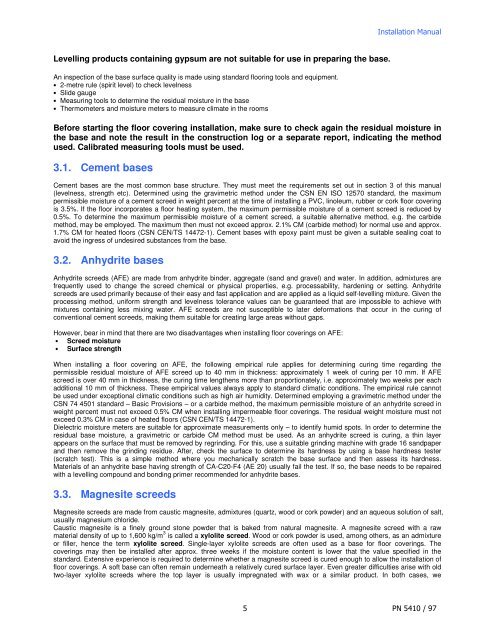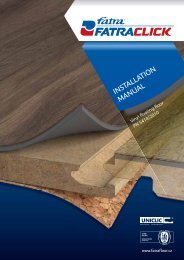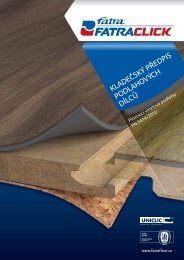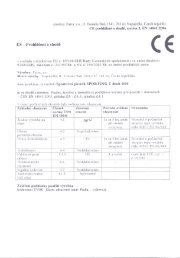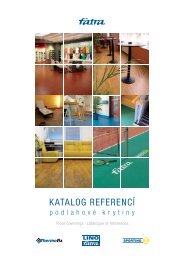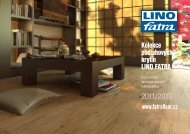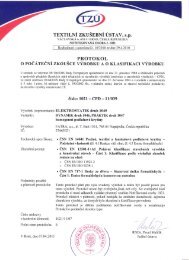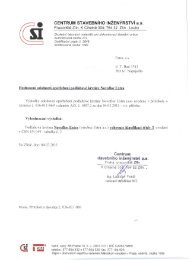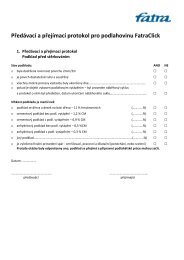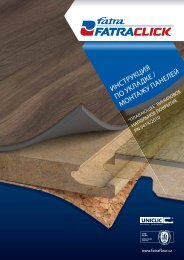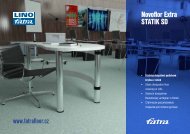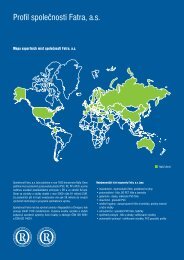Installation Manual - Fatra
Installation Manual - Fatra
Installation Manual - Fatra
Create successful ePaper yourself
Turn your PDF publications into a flip-book with our unique Google optimized e-Paper software.
Levelling products containing gypsum are not suitable for use in preparing the base.<br />
An inspection of the base surface quality is made using standard flooring tools and equipment.<br />
• 2-metre rule (spirit level) to check levelness<br />
• Slide gauge<br />
• Measuring tools to determine the residual moisture in the base<br />
• Thermometers and moisture meters to measure climate in the rooms<br />
Before starting the floor covering installation, make sure to check again the residual moisture in<br />
the base and note the result in the construction log or a separate report, indicating the method<br />
used. Calibrated measuring tools must be used.<br />
3.1. Cement bases<br />
Cement bases are the most common base structure. They must meet the requirements set out in section 3 of this manual<br />
(levelness, strength etc). Determined using the gravimetric method under the CSN EN ISO 12570 standard, the maximum<br />
permissible moisture of a cement screed in weight percent at the time of installing a PVC, linoleum, rubber or cork floor covering<br />
is 3.5%. If the floor incorporates a floor heating system, the maximum permissible moisture of a cement screed is reduced by<br />
0.5%. To determine the maximum permissible moisture of a cement screed, a suitable alternative method, e.g. the carbide<br />
method, may be employed. The maximum then must not exceed approx. 2.1% CM (carbide method) for normal use and approx.<br />
1.7% CM for heated floors (CSN CEN/TS 14472-1). Cement bases with epoxy paint must be given a suitable sealing coat to<br />
avoid the ingress of undesired substances from the base.<br />
3.2. Anhydrite bases<br />
Anhydrite screeds (AFE) are made from anhydrite binder, aggregate (sand and gravel) and water. In addition, admixtures are<br />
frequently used to change the screed chemical or physical properties, e.g. processability, hardening or setting. Anhydrite<br />
screeds are used primarily because of their easy and fast application and are applied as a liquid self-levelling mixture. Given the<br />
processing method, uniform strength and levelness tolerance values can be guaranteed that are impossible to achieve with<br />
mixtures containing less mixing water. AFE screeds are not susceptible to later deformations that occur in the curing of<br />
conventional cement screeds, making them suitable for creating large areas without gaps.<br />
However, bear in mind that there are two disadvantages when installing floor coverings on AFE:<br />
• Screed moisture<br />
• Surface strength<br />
When installing a floor covering on AFE, the following empirical rule applies for determining curing time regarding the<br />
permissible residual moisture of AFE screed up to 40 mm in thickness: approximately 1 week of curing per 10 mm. If AFE<br />
screed is over 40 mm in thickness, the curing time lengthens more than proportionately, i.e. approximately two weeks per each<br />
additional 10 mm of thickness. These empirical values always apply to standard climatic conditions. The empirical rule cannot<br />
be used under exceptional climatic conditions such as high air humidity. Determined employing a gravimetric method under the<br />
CSN 74 4501 standard – Basic Provisions – or a carbide method, the maximum permissible moisture of an anhydrite screed in<br />
weight percent must not exceed 0.5% CM when installing impermeable floor coverings. The residual weight moisture must not<br />
exceed 0.3% CM in case of heated floors (CSN CEN/TS 14472-1).<br />
Dielectric moisture meters are suitable for approximate measurements only – to identify humid spots. In order to determine the<br />
residual base moisture, a gravimetric or carbide CM method must be used. As an anhydrite screed is curing, a thin layer<br />
appears on the surface that must be removed by regrinding. For this, use a suitable grinding machine with grade 16 sandpaper<br />
and then remove the grinding residue. After, check the surface to determine its hardness by using a base hardness tester<br />
(scratch test). This is a simple method where you mechanically scratch the base surface and then assess its hardness.<br />
Materials of an anhydrite base having strength of CA-C20-F4 (AE 20) usually fail the test. If so, the base needs to be repaired<br />
with a levelling compound and bonding primer recommended for anhydrite bases.<br />
3.3. Magnesite screeds<br />
Magnesite screeds are made from caustic magnesite, admixtures (quartz, wood or cork powder) and an aqueous solution of salt,<br />
usually magnesium chloride.<br />
Caustic magnesite is a finely ground stone powder that is baked from natural magnesite. A magnesite screed with a raw<br />
material density of up to 1,600 kg/m 3 is called a xylolite screed. Wood or cork powder is used, among others, as an admixture<br />
or filler, hence the term xylolite screed. Single-layer xylolite screeds are often used as a base for floor coverings. The<br />
coverings may then be installed after approx. three weeks if the moisture content is lower that the value specified in the<br />
standard. Extensive experience is required to determine whether a magnesite screed is cured enough to allow the installation of<br />
floor coverings. A soft base can often remain underneath a relatively cured surface layer. Even greater difficulties arise with old<br />
two-layer xylolite screeds where the top layer is usually impregnated with wax or a similar product. In both cases, we


